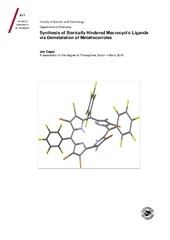Synthesis of Sterically Hindered Macrocyclic Ligands via Demetalation of Metallocorroles
Permanent lenke
https://hdl.handle.net/10037/9640Åpne
Thesis introduction (PDF)
Paper 1: Capar, J., Thomas, K. E., Ghosh, A.: “Reductive Demetallation of Copper Corroles: First Simple Route to Free-Base β-Octabromocorroles.”. Also available in Journal of Porphyrins and Phthalocyanines, 2008, 12(8): 964–967. (PDF)
Paper 2: Capar, J., Hansen, L.-K., Conradie, J., Ghosh, A. : “β-octabromo-meso-tris(pentafluorophenyl) corrole: Reductive demetalation-based synthesis of a heretofore inaccessible, perhalogenated free-base corrole.” Also available in Journal of Porphyrins and Phthalocyanines, 2010, 14, 509–512. (PDF)
Paper 3: Capar, J., Conradie, J., Beavers, C. M., Ghosh A.: “Molecular Structures of Free-Base Corroles: Nonplanarity, Chirality, and Enantiomerization”. Also available in Journal of Physical Chemistry A 2015, 119(14):3452–3457. (PDF)
Paper 4: Capar, J., Berg, S., Thomas, K. E., Beavers, C. M., Gagnon, K. J., Ghosh, A.: “Improved syntheses of β-octabromo-meso-triarylcorrole derivatives”. Also available in Journal of Inorganic Biochemistry 2015, 153(December):162–166. (PDF)
Paper 5: Norheim, H.-K., Capar, J., Einrem R. F., Gagnon, K. J., Beavers, C. M., Vazquez-Lima, H., Ghosh, A.: “Ligand noninnocence in FeNO corroles: insights from β-octabromocorrole complexes”. Also available in Dalton Transactions 2016, 45(2): 681–689. (PDF)
Paper 6: Capar, J., Zonneveld, J., Berg, S., Isaksson, J., Gagnon, K. J., Thomas, K. E., Ghosh, A.: “Demetalation of Copper Undecaarylcorroles: Molecular Structures of a Free-Base Undecaarylisocorrole and a Gold Undecaarylcorrole”. (Manuscript). Published version available in Journal of Inorganic Biochemistry 2016. (PDF)
Dato
2016-06-07Type
Doctoral thesisDoktorgradsavhandling
Forfatter
Capar, JanSammendrag
Despite important developments in synthetic corrole chemistry, the field has long been handicapped by the lack of procedures for demetalation of metallocorroles. This thesis presents general demetalation methods for metallocorroles. A reductive demetalation method was developed using concentrated H2SO4 with 5-200 equivalent of FeCl2 or SnCl2 as a reducing agent. The method proved to be quite general in that, by adjusting the amount of the reducing agent, various electron-rich and -deficient copper corroles could be demetalated in good yields. This discovery is described in Paper I. The reductive demetalation method was also applicable for manganese corroles by tuning the temperature. In this way, the highly electron-deficient and sterically crowded β-octabromo-meso-tris(pentafluorophenyl)-corrole ligand was synthesized, as described in Paper II. Low resolution X-ray data and DFT calculations demonstrated that the unusual nonplanar distortion of the free-base corrole is a direct result of the repulsion among the inner core hydrogens. High-resolution X-ray analysis of the free-base corrole finally proved possible (Paper III), allowing the assignment of the inner hydrogens corresponding to a specific tautomer. However, DFT calculations revealed no significant energy difference between the two possible tautomers. Sterically hindered free-base octabromocorrole ligands obtained by the above demetalation methods were utilized to synthesize iron octabromocorrole complexes, two of which were characterized by single-crystal X-ray diffraction analyses. These are presented in Papers IV and V. Isocorroles are new members of the porphyrinoid family, about which little is known. They are nevertheless of great interest as reagents in photodynamic therapy on account of their strong absorption in the near-infrared. I developed a general method for synthesizing undecaarylisocorroles and this is the subject of Paper VI.
Forlag
UiT Norges arktiske universitetUiT The Arctic University of Norway
Metadata
Vis full innførselSamlinger
Copyright 2016 The Author(s)
Følgende lisensfil er knyttet til denne innførselen:


 English
English norsk
norsk
